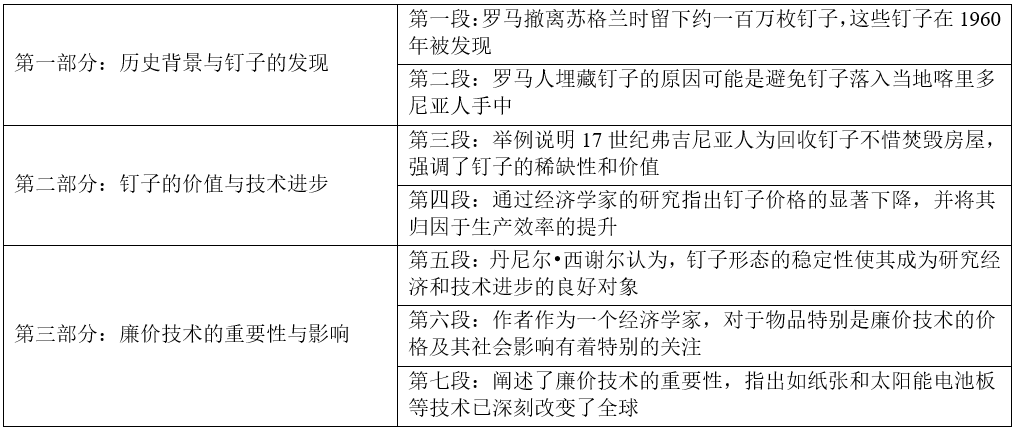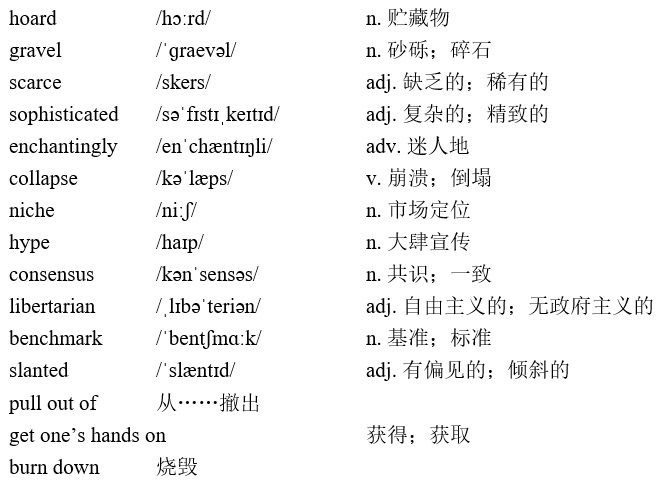Nearly 2,000 years ago, as the Romans began to pull out of Scotland, they left behind a curious treasure: 10 tons of nails, nearly a million of the things. The nail hoard was discovered in 1960 in a four-meter-deep pit covered by two meters of gravel.
Why had the Romans buried a million nails? The likely explanation is that the withdrawal was rushed, and they didn’t want the local Caledonians getting their hands on 10 tons of weapon-grade iron. The Romans buried the nails so deep that they would not be discovered for almost two millennia.
Later civilizations would value the skilled blacksmith’s labor in a nail even more than the raw material. As Roma Agrawal explains in her new delightful book Nuts and Bolts, early 17th-century Virginians would sometimes burn down their homes if they were planning to relocate. This was an attempt to recover the valuable nails, which could be reused after sifting the ashes. The idea that one might burn down an entire house just to reclaim the nails underlines how scarce, costly and valuable the simple-seeming technology was.
The price of nails fell by 90% between the late 1700s and mid-1900s, as economist Daniel Sichel points out in a research paper. According to Sichel, although the falling price of nails was driven partly by cheaper iron and cheaper energy, most of the credit goes to nail manufacturers who simply found more efficient ways to turn steel into nails.
Nails themselves have changed over the years, but Sichel studied them because they haven’t changed much. Roman lamps and Roman chariots are very different from LED strips and sports cars, but Roman nails are still clearly nails. It would be absurd to try to track the changing price of sports cars since 1695, but to ask the same question of nails makes perfect sense.
I make no apology for being obsessed by a particular feature of these objects: their price. I am an economist, after all. After writing two books about the history of inventions, one thing I’ve learnt is that while it is the enchantingly sophisticated technologies that get all the hype, it’s the cheap technologies that change the world.
The Gutenberg printing press transformed civilization not by changing the nature of writing but by changing its cost—and it would have achieved little without a parallel collapse in the price of surfaces to write on, thanks to an often-overlooked technology called paper. Solar panels had few niche uses until they became cheap; now they are transforming the global energy system.
1. The Romans buried the nails probably for the sake of ________.
2. The example of early 17th-century Virginians is used to ________.
3. What played the major role in lowering the price of nails after the late 1700s?
4. It can be learned from Paragraph 5 that nails ________.
5. Which of the following best summarizes the last two paragraphs?
问题1选项
A.saving them for future use
B.keeping them from rusting
C.letting them grow in value
D.hiding them from the locals
问题2选项
A.highlight the thriftiness of early American colonists
B.illustrate the high status of blacksmiths in that period
C.contrast the attitudes of different civilizations towards nails
D.show the preciousness of nail-making technology at that time
问题3选项
A.Increased productivity.
B.Wider use of new energies.
C.Fiercer market competition.
D.Reduced cost of raw materials.
问题4选项
A.have undergone many technological improvements
B.have remained basically the same since Roman times
C.are less studied than other everyday products
D.are one of the world’s most significant inventions
问题5选项
A.Cheap technologies bring about revolutionary change.
B.Technological innovation is integral to economic success.
C.Technology defines people’s understanding of the world.
D.Sophisticated technologies develop from small inventions.
第1题:D
第2题:D
第3题:A
第4题:B
第5题:A
第1题:
【整体分析】
来源:Financial Times《金融时报》于2023年6月16日刊登的文章What the Price of an Ancient Roman Nail Tells Us About Value(古罗马钉子的价格告诉我们什么是价值)。
主题:本文主要讨论了历史上钉子的价值和价格的变化,以及廉价技术对世界的影响。文章通过罗马人埋藏钉子、17世纪弗吉尼亚人回收钉子和钉子价格随时间下降的例子,展示了技术进步如何降低生产成本并改变社会结构。作者强调,简单但重要的技术革新对经济和社会的深远影响,指出廉价技术往往带来重大变革。
结构:

【试题解析】
【选项释义】
The Romans buried the nails probably for the sake of ________. 罗马人埋葬钉子可能是为了 ________。
A. saving them for future use A. 保存起来以备将来使用
B. keeping them from rusting B. 防止它们生锈
C. letting them grow in value C. 让它们增值
D. hiding them from the locals D. 向当地人隐藏它们
【考查点】事实细节题。
【解题思路】根据题干关键词buried the nails probably for the sake of可以定位到文章第二段第二句The likely explanation is that the withdrawal was rushed, and they didn’t want the local Caledonians getting their hands on 10 tons of weapon-grade iron.(可能的解释是撤退太匆忙,他们不想让当地的喀里多尼亚人得到10吨武器级的铁。),说明罗马人把钉子埋起来是为了不让当地人得到这些铁。因此D选项“向当地人隐藏它们”正确。
【干扰项排除】
A选项“保存起来以备将来使用”,B选项“防止它们生锈”和C选项“让它们增值”在文中均没有提及,属于无中生有。
第2题:
【选项释义】
The example of early 17th-century Virginians is used to ________. 17 世纪早期弗吉尼亚人的例子被用来 ________。
A. highlight the thriftiness of early American colonists A. 突出美国早期殖民者的节俭
B. illustrate the high status of blacksmiths in that period B. 说明当时铁匠的崇高地位
C. contrast the attitudes of different civilizations towards nails C. 对比不同文明对钉子的态度
D. show the preciousness of nail-making technology at that time D. 展示当时制钉技术的珍贵性
【考查点】事实细节题。
【解题思路】根据题干关键词early 17th-century Virginians可以定位到文章第三段第二、三、四句As Roma Agrawal explains in her new delightful book Nuts and Bolts, early 17th-century Virginians would sometimes burn down their homes if they were planning to relocate. This was an attempt to recover the valuable nails, which could be reused after sifting the ashes. The idea that one might burn down an entire house just to reclaim the nails underlines how scarce, costly and valuable the simple-seeming technology was.(正如罗玛·阿格拉瓦尔在她令人愉快的新书《螺母与螺栓》中所解释的那样,17世纪早期的弗吉尼亚人如果打算搬迁,有时会烧毁自己的房屋。这样做的目的是为了回收有价值的钉子,这些钉子可以在筛过灰烬后重新使用。为了找回钉子,人们可能会烧毁整栋房屋,这凸显了这项看似简单的技术是多么稀缺、昂贵和宝贵。),说明当时钉子价值很高,甚至可以让人们烧掉房屋来回收,体现了当时制钉技术的珍贵。因此D选项“展示当时制钉技术的珍贵性”正确。
【干扰项排除】
A选项“突出美国早期殖民者的节俭”,B选项“说明当时铁匠的崇高地位”和C选项“对比不同文明对钉子的态度”在文中均没有提及,属于无中生有。
第3题:
【选项释义】
What played the major role in lowering the price of nails after the late 1700s? 在17世纪晚期之后,什么对降低钉子的价格起了主要作用?
A. Increased productivity. A. 生产力的提高。
B. Wider use of new energies. B. 新能源的广泛使用。
C. Fiercer market competition. C. 更激烈的市场竞争。
D. Reduced cost of raw materials. D. 原材料成本降低。
【考查点】推理判断题。
【解题思路】根据题干关键词lowering the price of nails after the late 1700s可以定位到文章第四段第二句According to Sichel, although the falling price of nails was driven partly by cheaper iron and cheaper energy, most of the credit goes to nail manufacturers who simply found more efficient ways to turn steel into nails.(西谢尔认为,虽然钉子价格下降的部分原因是铁和能源变得更便宜,但大部分功劳应归功于钉子制造商,他们只是找到了更有效的方法将钢铁变成钉子。),说明更有效的方法带来了生产力的提高,在钉子价格下降中起了主要作用。因此A选项“生产力的提高。”正确。
【干扰项排除】
B选项“新能源的广泛使用。”和C选项“更激烈的市场竞争。”在文中没有提及,属于无中生有;
D选项“原材料成本降低。”,由although the falling price of nails was driven partly by cheaper iron and cheaper energy(虽然钉子价格下降的部分原因是铁和能源变得更便宜)可知,这只是部分原因,而不是主要原因,属于以偏概全。
第4题:
【选项释义】
It can be learned from Paragraph 5 that nails ________. 从第五段可以看出,钉子________。
A. have undergone many technological improvements A. 经历了许多技术改进
B. have remained basically the same since Roman times B. 自罗马时代以来基本保持不变
C. are less studied than other everyday products C. 与其他日常用品相比,对钉子的研究较少
D. are one of the world’s most significant inventions D. 是世界上最重要的发明之一
【考查点】事实细节题。
【解题思路】根据题干关键词Paragraph 5可以定位到文章第五段第一、二句Nails themselves have changed over the years, but Sichel studied them because they haven’t changed much. Roman lamps and Roman chariots are very different from LED strips and sports cars, but Roman nails are still clearly nails.(多年来,钉子本身已经发生了变化,但西谢尔之所以研究钉子,是因为它们并没有太大变化。罗马灯和罗马战车与LED灯带和跑车截然不同,但罗马钉子显然仍然是钉子。),说明钉子自罗马时代以来没有发生太大变化。因此B选项“自罗马时代以来基本保持不变”正确。
【干扰项排除】
A选项“经历了许多技术改进”,由but Sichel studied them because they haven’t changed much(但西谢尔之所以研究钉子,是因为它们并没有太大变化)可知,钉子没有经历许多技术改进,属于反向干扰;
C选项“与其他日常用品相比,对钉子的研究较少”和D选项“是世界上最重要的发明之一”在文中没有提及,属于无中生有。
第5题:
【选项释义】
Which of the following best summarizes the last two paragraphs? 以下哪项最能概括最后两段的内容?
A. Cheap technologies bring about revolutionary change. A. 廉价技术带来了革命性的变化。
B. Technological innovation is integral to economic success. B. 技术创新是经济成功不可或缺的因素。
C. Technology defines people’s understanding of the world. C. 技术决定了人们对世界的理解。
D. Sophisticated technologies develop from small inventions. D. 尖端技术是由小发明发展而来的。
【考查点】主旨大意题。
【解题思路】第六段最后一句说到while it is the enchantingly sophisticated technologies that get all the hype, it’s the cheap technologies that change the world(虽然令人着迷的尖端技术被大肆炒作,但改变世界的却是廉价技术),提出了廉价技术改变世界的观点,接着第七段提到The Gutenberg printing press transformed civilization not by changing the nature of writing but by changing its cost(古腾堡印刷机改变了人类文明,不是因为它改变了书写的本质,而是因为它改变了书写的成本)和Solar panels had few niche uses until they became cheap; now they are transforming the global energy system.(太阳能电池板在变得便宜之前,几乎没有什么细分用途;现在,它们正在改变全球能源系统。),这两个例子是对该观点的进一步证明,说明最后两段的主要内容是廉价技术带来了革命性变化。因此A选项“廉价技术带来了革命性的变化。”正确。
【干扰项排除】
B选项“技术创新是经济成功不可或缺的因素。”,C选项“技术决定了人们对世界的理解。”和D选项“尖端技术是由小发明发展而来的。”在文中均无法体现,属于无中生有。
【重点词汇】

【长难句分析】
1. The idea that one might burn down an entire house just to reclaim the nails underlines how scarce, costly and valuable the simple-seeming technology was.
【结构分析】

【补充分析】
① that引导同位语从句,进一步解释说明前面的名词idea,说明人们为了回收钉子可能会采取烧毁整栋房子的行动;
② how引导宾语从句,充当动词underlines的宾语,强调了这种看似简单的技术实际上是多么稀缺、昂贵和有价值。
【参考译文】为了找回钉子,人们可能会烧毁整栋房屋,这凸显了这项看似简单的技术是多么稀缺、昂贵和宝贵。
2. According to Sichel, although the falling price of nails was driven partly by cheaper iron and cheaper energy, most of the credit goes to nail manufacturers who simply found more efficient ways to turn steel into nails.
【结构分析】

【补充分析】
① although引导让步状语从句,建立一种对比,表明尽管存在钉子价格下降部分是由于铁和能源成本降低的原因,但主句中所述的制钉商找到更有效率的生产方法才是主要功劳所在;
② who引导定语从句修饰nail manufacturers,进一步描述制钉商如何对降低钉子价格起到关键作用:即他们找到了更有效的方法将钢材制成钉子。
【参考译文】西谢尔认为,虽然钉子价格下降的部分原因是铁和能源变得更便宜,但大部分功劳应归功于钉子制造商,他们只是找到了更有效的方法将钢铁变成钉子。
【全文翻译】
近2000年前,当罗马人开始撤离苏格兰时,他们留下了一批奇怪的宝藏:10吨钉子,将近一百万枚。这批钉子在1960年被发现,它们位于一个被两米厚砾石覆盖的四米深坑中。
罗马人为什么要埋藏一百万枚钉子呢?可能的解释是撤退太匆忙,他们不想让当地的喀里多尼亚人得到10吨武器级的铁。罗马人把钉子埋得很深,以至于将近两千年都没有人发现它们。
后来的文明更看重铁钉中熟练的铁匠劳动的价值,甚至超过原材料。正如罗玛·阿格拉瓦尔在她令人愉快的新书《螺母与螺栓》中所解释的那样,17世纪早期的弗吉尼亚人如果打算搬迁,有时会烧毁自己的房屋。这样做的目的是为了回收有价值的钉子,这些钉子可以在筛过灰烬后重新使用。为了找回钉子,人们可能会烧毁整栋房屋,这凸显了这项看似简单的技术是多么稀缺、昂贵和宝贵。
经济学家丹尼尔·西谢尔在一篇研究论文中指出,从18世纪晚期到20世纪中期,钉子的价格下降了90%。西谢尔认为,虽然钉子价格下降的部分原因是铁和能源变得更便宜,但大部分功劳应归功于钉子制造商,他们只是找到了更有效的方法将钢铁变成钉子。
多年来,钉子本身已经发生了变化,但西谢尔之所以研究钉子,是因为它们并没有太大变化。罗马灯和罗马战车与LED灯带和跑车截然不同,但罗马钉子显然仍然是钉子。试图追踪跑车自1695年以来的价格变化是荒谬的,但对钉子提出同样的问题却非常合理。
我对这些物品的某个特征着迷,并对此毫无歉意:那就是它们的价格。毕竟,我是一名经济学家。在写了两本关于发明史的书之后,我学到的一点是,虽然令人着迷的尖端技术被大肆炒作,但改变世界的却是廉价技术。
古腾堡印刷机改变了人类文明,不是因为它改变了书写的本质,而是因为它改变了书写的成本——如果书写表面的价格没有随之大幅下降,那么它就不会取得什么成就,这要归功于一种经常被忽视的技术:即纸张。太阳能电池板在变得便宜之前,几乎没有什么细分用途;现在,它们正在改变全球能源系统。